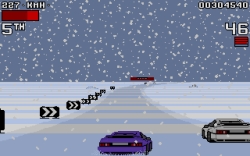Lotus (series)
| Lotus Esprit Turbo Challenge | |
|---|---|

Amiga screenshot of Lotus Esprit Turbo Challenge, which allowed for simultaneous play between two human players.
|
|
| Developer(s) | Magnetic Fields |
| Publisher(s) | Gremlin Graphics |
| Composer(s) | Barry Leitch, Patrick Phelan |
| Platform(s) | Amiga, Amiga CD32 (part of Lotus Trilogy), Amstrad CPC, Atari ST, Commodore 64, ZX Spectrum |
| Release | 1990 |
| Genre(s) | Racing |
| Mode(s) | Single-player, multiplayer |
| Lotus Turbo Challenge 2 | |
|---|---|

Amiga screenshot of
Lotus Turbo Challenge 2 |
|
| Developer(s) | Magnetic Fields |
| Publisher(s) | Gremlin Graphics |
| Composer(s) | Barry Leitch |
| Platform(s) | Amiga, Amiga CD32 (part of Lotus Trilogy), Atari ST, Acorn Archimedes, Sega Genesis |
| Release | 1991 |
| Genre(s) | Racing |
| Mode(s) | Single-player, multiplayer |
| Lotus III: The Ultimate Challenge | |
|---|---|

MS-DOS screenshot of
Lotus III: The Ultimate Challenge |
|
| Developer(s) | Magnetic Fields |
| Publisher(s) | Gremlin Graphics |
| Composer(s) | Patrick Phelan (composer) |
| Platform(s) | Amiga, Amiga CD32 (part of Lotus Trilogy), Atari ST, MS-DOS, Sega Genesis |
| Release | 1992 |
| Genre(s) | Racing |
| Mode(s) | Single-player, multiplayer |
The Lotus series consists of three racing computer games based around the Lotus brand: Lotus Esprit Turbo Challenge, Lotus Turbo Challenge 2, and Lotus III: The Ultimate Challenge. Published between 1990 and 1992 by Gremlin Graphics, the games gained very favourable reviews upon release. Original Amiga versions of the games were created by Shaun Southern and Andrew Morris of Magnetic Fields, and then ported by other individuals to several other computers and game consoles.
The first game in the series was released in 1990 for most popular contemporary 8-bit and 16-bit computer systems, the Amiga version being the most technically advanced. The game allowed the player to race a Lotus Esprit Turbo SE car through several (32 in the Amiga version) circuit race tracks of varying scenery. Two player simultaneous play (with split screen) was also provided, and a choice of audio tracks to accompany races.
Each track is lap-based and consists of turns of varying degrees, as well as hills and hollows which slow down or speed up the car passing through them. Each turn is indicated by a chain of road-side signs, and the difficulty of the turn is reflected by the number and density of these signs - a feature common to all titles in the Lotus series.
While racing, the players must manage their fuel supply, occasionally visiting the pit stop for refuelling. Also apart from overtaking the other cars, the racers must avoid various hazards and obstacles. These are dependent on the scenery the track is located in, and include slippery road on the winter courses, road blocks, slippery puddles and wooden logs.
The tracks are split into three race series, with different difficulty levels. In each race the player or players compete against 20 opponents. The goal is to finish each race on the highest possible position; if the player finishes a race within the first 10 places they qualify for the next race and receive points towards a final position on the high-score table. The names of the computer-controlled drivers are puns on the names of real-life racers of the time ("Ayrton Sendup", "Nijel Mainsail" and "Alain Phosphate" for example).
...
Wikipedia
